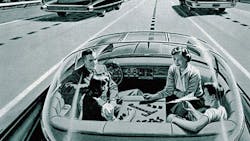Autonomous trucking could disrupt the (freight) world
The first documented idea of an autonomous car was introduced in the New York World’s Fair in 1939 in the Futurama exhibit as part of General Motors’ vision of the future of America in 20 years. Nearly 70 years later, we are well on our way to an autonomous future with the goal of making driving safer and more efficient for all. In fact, scientists predict that self-driving cars will greatly reduce — if not completely eliminate — car accidents in the near future.
The main focus of autonomous driving has been about enabling driverless passenger cars, but as technology has advanced, the conversation has shifted from solving for the driver to talking about how autonomy can positively change the roads for freight trucks and fleet drivers as well.
There is a perfect storm that exists within advancements of autonomous trucking which makes the future of it both viable and attractive: easier routing, made even easier with advanced mapping systems of recent years (advancing more each quarter), and elimination of human error.
Weathering road conditions
It’s no secret that truck drivers face long shifts on less than populated highways, often long into the evening or early morning; deliveries don’t sleep in locations far in the North, not even during the coldest, shortest days of the year. Large vehicles with these extensive loads, traveling long distances, have a large history of emergencies, unexpected issues, and mental and physical wear on the drivers who use them.
Trucks are heavier than passenger cars, contain loads of variable physical sizes and potentially unusual dimensions, making them hard to maneuver with today’s “standard” popular crash-avoidance and lane assistance software, and cannot be treated the same way during emergency stops. Sensors cannot be placed at the exact same locations to help with this process and must be adapted to the unique measurements of these vehicles.
And yet, all of these factors have not halted development, whether a truck needs to accommodate regular load transport at all times of day, at high speeds, or in moderate weather, with some of the most dangerous conditions soon underway.
This suggests a safer, brighter future for the transportation industry, computers create reactions impossible for humans in the direst of circumstances. Developments like these prove to revolutionize one of the most heavily relied on, but simultaneously risk-heavy, industries.
The long road to autonomous adoption
Progress in recent months within autonomous trucking again tells us that companies have succeeded in creating trucks that can self-pilot across more substantial distances, with testing primarily in the Southwest. As these vehicles travel primarily on established, large freeways, routing becomes simple without adjusting for complex parking, traffic, and small city street dimensions.
The types of freeways present in these areas also raise a lot of questions in terms of adaptability, as trucking roads are not designed equal throughout the world.
While technology advances forward, there will inevitably be delays from the production of driverless trucks to their legal use on roads. What form this takes can splinter in countless directions for countless reasons; the purpose of the truck, in which specific state or region it is being used, perhaps even the views of the local population and their desire to share the road with autonomous systems of this size.
Ultimately, it may not be several years before widespread adoption, but the progress is still coming faster than many might expect. For some, this progress also comes at great personal concern — namely, the fate of truck drivers, who currently comprise 3.2 million workers in Europe alone.
Not phased out
Truck drivers have been at the root of concern of being at risk for redundancy, as self-driving capabilities in cars have increased to most commonly include driving on highways for more substantial stretches of time within their offerings. Several companies, such as Waymo and Starsky Robotics, have logged countless driverless truck hours in the past years in familiar trucking territory.
Despite these advancements and concerns, there are many factors requiring human supervision which leaves many aspects of this job potentially secure. Trucks cannot, at this point, deliver their own maintenance, or respond to construction workers or police giving verbal commands. There is a level of human interaction that cannot be replicated by systems that do not have the communications functionalities separate from their self-driving technology.
Trucking into the next decade
While less popular in the public eye, autonomous long-range hauling is likely to evolve over the next several years as countries and companies decide how to integrate the new systems which look to disrupt a core industry in world transportation.
This disruption can be seen as the best of both worlds — the optimization of safety and the promise of reduced job displacement. This innovation will protect lives on the road and will work in tandem with visions for increasingly optimized delivery systems with fewer anticipated road casualties.
Olivia Vahsen is a developer evangelist at TomTom, a location technology specialist.About the Author
Olivia Vahsen
Olivia Vahsen is a developer evangelist at TomTom, a location technology specialist.
